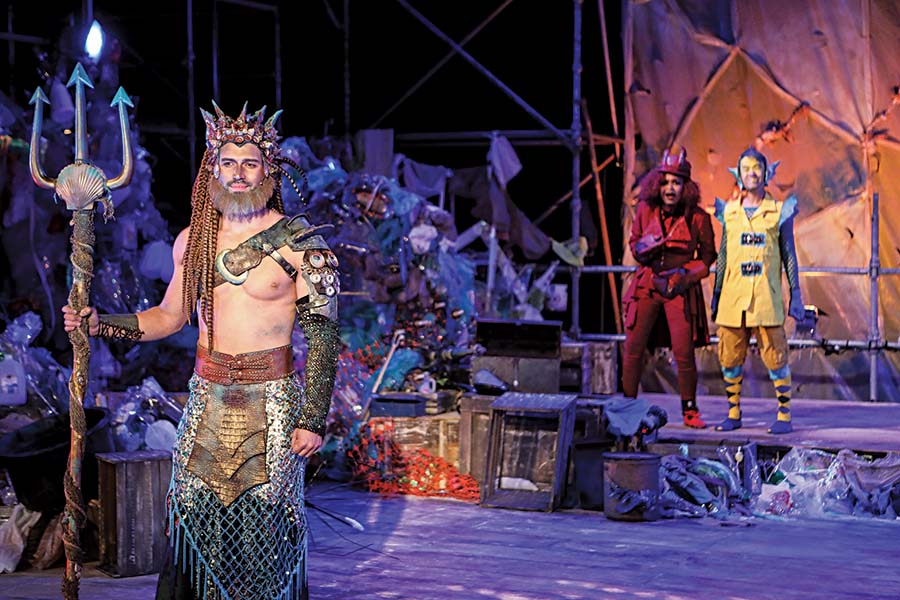Around the world, hurricanes have grown in intensity and heat records are being hit on an annual basis. These extreme weather events, powered by climate change, has not spared theatres. The Oregon Shakespeare Festival had to cancel numerous shows and lost $2 million worth of revenue because of local wildfires, which get worse every year. The Alley Theatre suffered $18 million worth of damages from Hurricane Harvey.
In an effort to do their part, many theatre companies have adopted eco-friendly administrative practices. But these don’t always extend into the design process, which can generate tons of waste, as props, sets, and costumes are rarely reused. Fortunately the Broadway Green Alliance and the UK Organization Julie’s Bicycle both have online resources for establishing company guidelines and policies.
Many different factors will influence an individual theatre’s policies, including whether the company owns its space, storage capabilities, budget, and what resources are available in that community. But having best practices established can help guide the design process.
One straightforward way to invest in eco-friendly design is in the selection of materials. As the U.S. has seen a push toward more energy-efficient lighting in the last decade, theatre lighting manufacturers have also introduced “green” products. The Broadway Green Alliance offers an overview of these lights as a jumping off point.
Likewise, when constructing a set, committing to “buying green” might not provide a net benefit to the environment, depending on where you live. For instance, for those in Oregon, “converting to Forest Stewardship Council certified lumber is easy,” says Ian Garrett, director of the Center for Sustainable Practice in the Arts. “But if you’re in Arizona, maybe not, since it has to ship in.” He suggests companies look at using more steel, “which is easily recycled.”
Limitations can force experimentation. In New York, the Off-Off-Broadway venue the Tank produces Dark Fest, a theatre festival in which productions may only use self-sufficient and alternative energy sources. “We have had artists use all sorts of different things, from glow-in-the-dark mouth guards to flash lights to a glowing blow-up sex doll,” says Tank co-artistic director Rosalind Grush.
Using materials already headed to landfills and recycling centers can have the greatest impact. Earlier this year Serenbe Playhouse in Georgia produced Disney’s The Little Mermaid using common recyclable household goods collected by the community. These raw materials were used to create the set and costumes in the show.
Sometimes finding the materials first, then letting the design emerge can lead to amazing results. When Donyale Werle was designing the set for Peter and the Starcatcher Off Broadway, she used leftover materials from Disney’s warehouse. Finding scraps of cloth too small to use in costumes, she instead strung them together to make the backdrop of her set. The play eventually went to Broadway and Werle won a Tony Award for her ingenuity.
Not every designer has a Disney warehouse to plunder, but that doesn’t mean there aren’t resources in your community. Most cities have organizations that will reclaim raw materials otherwise headed for landfills, then resell them cheaply to the public. The ReUse People of America have locations nationwide; other reuse centers include ReCONNstruction Center in Newington, Conn., Re-Use Hawai’I in Honolulu, Lifecycle Building Center in Atlanta, Community Forklift in Edmonston, Md., and EcoBuilding Bargains in Springfield, Mass.
Eco-friendly practices can include not just design materials but the process itself. “My sketches are all digital at the moment,” says costume designer Jennifer Caprio. She admits that “the thing I’m having the hardest time with as a costume designer is the boxes used in shipments from Amazon.”
The environmental impact of a production doesn’t end after the final curtain. Many theatre companies reuse their materials, but if they have no immediate use and there is no place to store them, it’s important to plan for their after-show life. What can be reused later? What other organizations in your community might be able to use them? The Broadway Green Alliance suggests budgeting time and money to make sure it doesn’t all end up in the landfill.
“We acknowledge that sustainability in the arts is culturally vital but insignificant as far as global environmental impact,” says Lanxing Fu, co-director of the New York-based Superhero Clubhouse, a performance group that makes eco-theatre. And indeed, fighting climate change requires actions at the national and international level. But like opting for steel straws instead of plastic, the actions of individuals, all in alignment, can add up to more than small change. —TJ Acena


